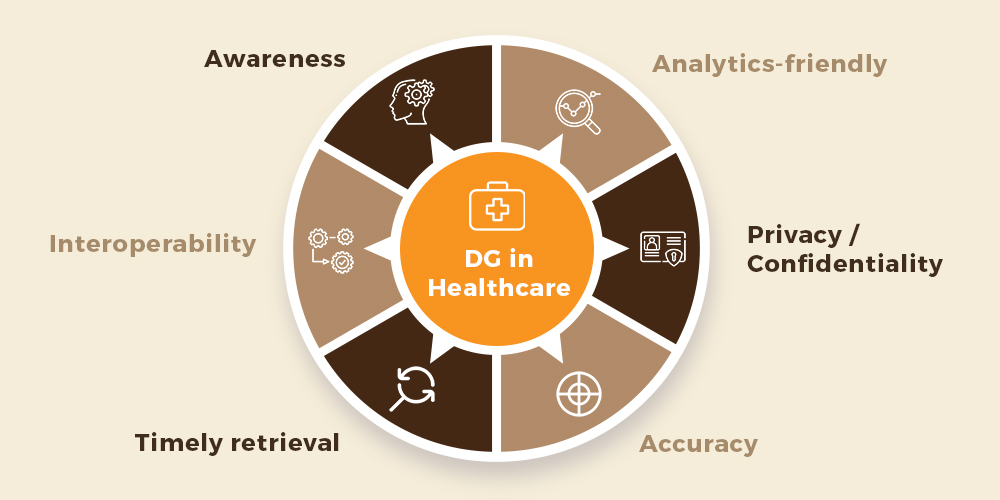
Everything is turning digital in healthcare - medical histories, telemetry, remote diagnostics etc. No part in the healthcare ecosystem remains untouched by digital. This in turn is leading to an explosion of data. But to make sense of the data, it should be available in the right format, at the right time and to the right people. And this is why a strong data governance policy is an absolute must in the healthcare industry. Here are some points you should keep in mind while setting up a data governance policy in healthcare.
.tb_button {padding:1px;cursor:pointer;border-right: 1px solid #8b8b8b;border-left: 1px solid #FFF;border-bottom: 1px solid #fff;}.tb_button.hover {borer:2px outset #def; background-color: #f8f8f8 !important;}.ws_toolbar {z-index:100000} .ws_toolbar .ws_tb_btn {cursor:pointer;border:1px solid #555;padding:3px} .tb_highlight{background-color:yellow} .tb_hide {visibility:hidden} .ws_toolbar img {padding:2px;margin:0px}

For an industry as impactful and omnipresent as it is, one would think data governance in healthcare would be an obvious prerequisite. Apparently, not. Some unhealthy statistics among US healthcare providers was unearthed in a recent study by Unisys: two-thirds of those surveyed rated themselves ‘laggards’ in terms of digital health initiatives, with only 16% of them even having a data governance policy.
.tb_button {padding:1px;cursor:pointer;border-right: 1px solid #8b8b8b;border-left: 1px solid #FFF;border-bottom: 1px solid #fff;}.tb_button.hover {borer:2px outset #def; background-color: #f8f8f8 !important;}.ws_toolbar {z-index:100000} .ws_toolbar .ws_tb_btn {cursor:pointer;border:1px solid #555;padding:3px} .tb_highlight{background-color:yellow} .tb_hide {visibility:hidden} .ws_toolbar img {padding:2px;margin:0px}
What does data governance mean in Healthcare?
If you are a professional working in the healthcare industry, you are probably aware of how big a role data plays in your daily routine. For instance, if you are a caregiver, you will deal with digitized medical histories and records, telemetry and remote diagnostics. Even X-Rays are now available in digital formats more often than not, and advances in Internet of Things promises a more closely connected world than seen until now. And if you are an administrator, there’s practically no part of the business chain that hasn’t been upgraded in the past few years. Payrolls, claims, cost and inventory controls, legal reporting and compliance… everything is digital.
That’s why, irrespective of the role you play in your organization today — be it as a healthcare information professional or a coder who manages the technology that hosts the data, a strong data governance policy has to rank among the topmost of your responsibilities.
.tb_button {padding:1px;cursor:pointer;border-right: 1px solid #8b8b8b;border-left: 1px solid #FFF;border-bottom: 1px solid #fff;}.tb_button.hover {borer:2px outset #def; background-color: #f8f8f8 !important;}.ws_toolbar {z-index:100000} .ws_toolbar .ws_tb_btn {cursor:pointer;border:1px solid #555;padding:3px} .tb_highlight{background-color:yellow} .tb_hide {visibility:hidden} .ws_toolbar img {padding:2px;margin:0px}
.tb_button {padding:1px;cursor:pointer;border-right: 1px solid #8b8b8b;border-left: 1px solid #FFF;border-bottom: 1px solid #fff;}.tb_button.hover {borer:2px outset #def; background-color: #f8f8f8 !important;}.ws_toolbar {z-index:100000} .ws_toolbar .ws_tb_btn {cursor:pointer;border:1px solid #555;padding:3px} .tb_highlight{background-color:yellow} .tb_hide {visibility:hidden} .ws_toolbar img {padding:2px;margin:0px}
Healthcare data governance: Important factors to consider
.tb_button {padding:1px;cursor:pointer;border-right: 1px solid #8b8b8b;border-left: 1px solid #FFF;border-bottom: 1px solid #fff;}.tb_button.hover {borer:2px outset #def; background-color: #f8f8f8 !important;}.ws_toolbar {z-index:100000} .ws_toolbar .ws_tb_btn {cursor:pointer;border:1px solid #555;padding:3px} .tb_highlight{background-color:yellow} .tb_hide {visibility:hidden} .ws_toolbar img {padding:2px;margin:0px}

In this blog post, we talk about data governance essentials every healthcare service provider must consider. Following these 8 commandments, you would have a blueprint for all things you need to consider before venturing on a new data governance initiative or updating your existing one.
01. Analytics-friendly
One of the key purposes of big data in healthcare is to use it, stripped of personally identifiable details, to derive macro patterns that can help healthcare organizations and government agencies learn, process and progress. For this to happen, the data needs to be stored in a format that is easily searchable, retrievable and analyzable.
02. Privacy/Confidentiality
Privacy of patient data is of utmost importance and its access should be controlled on a need-to-know basis. Only the physician or authorized caregivers/clinicians should be able to see data related to the patient’s medical history, diagnosis or treatment. It is in fact a legal requirement that the tenets of doctor-patient confidentiality should extend to data in its digital format as well.
03. Accuracy
Healthcare is one field where the integrity and veracity of the data stored/retrieved about the patient could literally be a matter of life and death. No matter how the data is input, transferred, stored or retrieved, it must remain accurate and tamper-proof. A wrongly-filled electronic health record, for instance, could very easily be fatal.
04. Timely retrieval
Data governance, while ensuring that there are adequate safeguards against unauthorized access, should not in itself become a hindrance to providing healthcare, particularly at critical junctures of triage and treatment. The right personnel, after all, must be given access to the right data at the right time. Hiding a record of allergies from emergency personnel, for instance, might lead to the administration of medicines that bring about anaphylactic shock.
05. Interoperability
For healthcare data to be put to use, it needs to flow between a number of systems: legacy and modern. At a micro-level, it will need to be transferred between various internal systems used within the hospital or healthcare centre. At a macro-level it will need to be shared outside this environment as well, such as a government organization, research lab or another hospital (in case of a referral.) The governance policy framed needs to factor in these various conditions and facilitate smooth data transfer under them.
06. Awareness
A sound data governance policy must also factor in technological illiteracy (or, to be more precise, under-literacy) of the users who will be a part of the data cycle. As a result, even aspects such as why a particular safeguard is in place, or how a certain data structure is essential to your organization can also be a part of the training rigor when a new policy is pushed out across the organization.
.tb_button {padding:1px;cursor:pointer;border-right: 1px solid #8b8b8b;border-left: 1px solid #FFF;border-bottom: 1px solid #fff;}.tb_button.hover {borer:2px outset #def; background-color: #f8f8f8 !important;}.ws_toolbar {z-index:100000} .ws_toolbar .ws_tb_btn {cursor:pointer;border:1px solid #555;padding:3px} .tb_highlight{background-color:yellow} .tb_hide {visibility:hidden} .ws_toolbar img {padding:2px;margin:0px}
Diagnosing your data governance policy
Data governance is more than just about doing one or two of the above, especially for the healthcare industry. With electronic health devices and records, cloud computing and AI-enabled diagnostics, transcription and triage, the sector is transitioning from a semi-digital landscape to a completely digitized one. Therefore, it requires a depth of focus and clarity right from the outset. There is neither time nor opportunity for an iterative process, for the costs of failure might be very high.
At I&I Software, we’ve perfected the 4-stage approach to data governance that incorporates industry best practices to ensure all your data goals are adequately met.
.tb_button {padding:1px;cursor:pointer;border-right: 1px solid #8b8b8b;border-left: 1px solid #FFF;border-bottom: 1px solid #fff;}.tb_button.hover {borer:2px outset #def; background-color: #f8f8f8 !important;}.ws_toolbar {z-index:100000} .ws_toolbar .ws_tb_btn {cursor:pointer;border:1px solid #555;padding:3px} .tb_highlight{background-color:yellow} .tb_hide {visibility:hidden} .ws_toolbar img {padding:2px;margin:0px}
.tb_button {padding:1px;cursor:pointer;border-right: 1px solid #8b8b8b;border-left: 1px solid #FFF;border-bottom: 1px solid #fff;}.tb_button.hover {borer:2px outset #def; background-color: #f8f8f8 !important;}.ws_toolbar {z-index:100000} .ws_toolbar .ws_tb_btn {cursor:pointer;border:1px solid #555;padding:3px} .tb_highlight{background-color:yellow} .tb_hide {visibility:hidden} .ws_toolbar img {padding:2px;margin:0px}
If you need help diagnosing your data governance policy, do reach out to us for a consultation
.tb_button {padding:1px;cursor:pointer;border-right: 1px solid #8b8b8b;border-left: 1px solid #FFF;border-bottom: 1px solid #fff;}.tb_button.hover {borer:2px outset #def; background-color: #f8f8f8 !important;}.ws_toolbar {z-index:100000} .ws_toolbar .ws_tb_btn {cursor:pointer;border:1px solid #555;padding:3px} .tb_highlight{background-color:yellow} .tb_hide {visibility:hidden} .ws_toolbar img {padding:2px;margin:0px}


